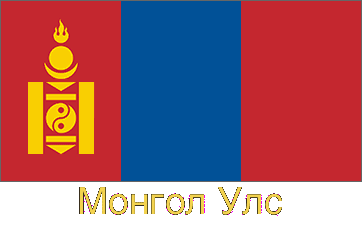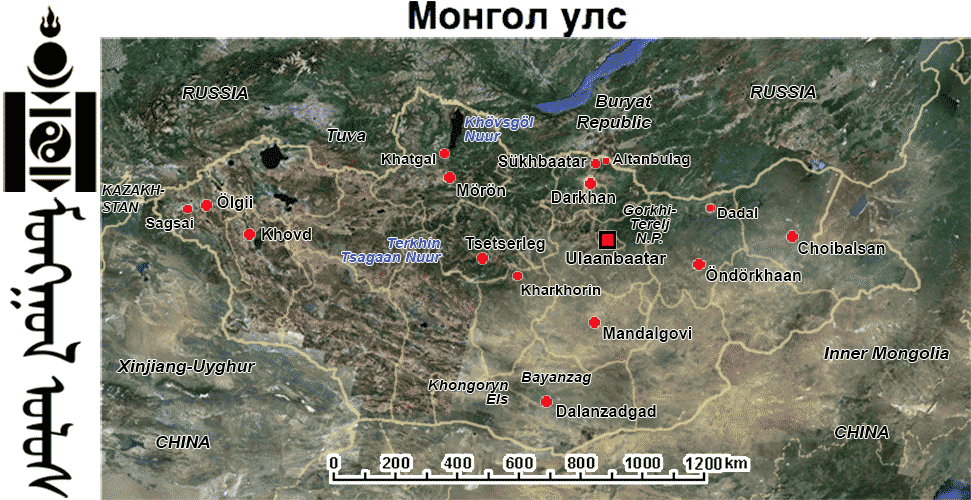Photos from Mongolia
| Home | About | Guestbook | Contact |
MONGOLIA - 2011

A short history of Mongolia
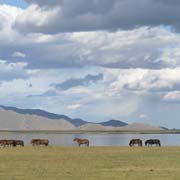
The Republic of Mongolia in East and Central Asia is the most sparsely populated independent country in the world, bordering Russia and China. It is a vast and empty country, with an area of 1,564,116 km² and a population of only around 2.75 million, of whom almost half live in the capital, Ulaanbaatar (Ulan Bator). Most of the country is covered by steppes, the grasslands of the nomads; there are mountains in the north, especially in the west, with the Khüiten Peak in the Tavan Bogd massif the highest point at 4,374 metres. The population is about 95% ethnic Mongol, with the main group (86%) being the Khalkha. Other Mongol groups are the Oirat in the west and the Buriad (Buryat), who live in the north, adjacent to Russia’s Buryat Republic. In the forests of northwestern Mongolia live small groups of Dukha or Tsaatan, reindeer herders speaking a Tuvan Turkic language. In the west, in Bayan Ölgii province, is a substantial population of Kazakhs, a Turkic people, making up almost 4% of the total population of Mongolia. The Mongolian script was introduced in the time of Genghis Khan. It was derived from the old Uyghur script, and it is still used in China’s Inner Mongolia region. Between 1941 and 1946, during Soviet domination of the country, the Cyrillic script was introduced with two extra symbols; this script is now used in Mongolia. The old lettering is taught again in schools and often displayed on monuments. It is written in vertical columns and more challenging to learn than the Cyrillic script, also used by the Kazakhs, with extra symbols to accommodate different sounds.
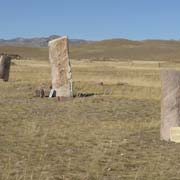
Modern humans have occupied the area that is now Mongolia for around 40,000 years, and there are various sites where cave paintings have been found. Around 5500 - 3500 BCE, there were agricultural settlements that, in the Copper and Bronze Age, from 3500 - 2500 BCE, gave way to a nomadic horse-riding lifestyle. Monuments like the “deer stones” as can be seen near Mörön and other sites date from those days. Metalwork and pastoral nomadism gradually became more developed, and in 209 BCE, the Xiongnu (or Hunnu) Empire was established over Mongolia and adjacent areas of present-day China, Kazakhstan and Kyrgyzstan. They were considered a threat to China’s Qin Dynasty, which constructed the Great Wall to protect itself from the devastating Xiongnu raids. In 93 CE, after the downfall of the Xiongnu, the Mongolic Xianbei state emerged and ruled over Mongolia and a vast area around it until 234 CE, when it fragmented into separate states. One of those states, the Rouran (or Nirun) Khanate (330 - 550), ruled over the steppes from Manchuria to Turpan in Xinjiang and parts of Siberia. A confederation broke their power, including the Göktürks, nomadic Turkic peoples who took over the Silk Road trade and ruled a vast empire, stretching far into Central Asia. Their rule lasted from 555 to 745 when they were succeeded by the Uyghur Khaganate, after a rebellion by different tribes against Göktürk rule, resulting in the prominence of the Uyghur leader. The Uyghur Empire, a highly civilised state, was massive, stretching from east China far into Central Asia. It eventually collapsed after Kyrgyz, living to the north, invaded in 840, sacked the Uyghur capital Ordu Baliq and destroyed their cities, causing the diaspora of Uyghur people across Central Asia. From 907 - 1125, Mongolic Khitans ruled Mongolia, followed by the Khamag (= “whole”) Mongols, who became the major power.
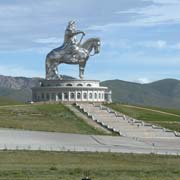
In 1168 a boy was born in Deluun Boldog, near the present village of Dadal, in the household of Yesukhei, leader of the Khamag Mongols. His name was Temujin, and he grew up to become the founder and the Great Khan of the Mongol Empire, the largest contiguous empire in history. He united many of the nomadic tribes and, in 1206, was proclaimed “Chinggis Khaan”, Genghis Khan. Waging a series of military campaigns that were renowned for their brutality and ferocity, he forged the Mongol Empire that, under his successors, stretched from Poland to Korea and from Siberia to the Persian Gulf and Vietnam. He decreed the Uyghur script as the empire’s writing system and promoted religious tolerance and the protection of ambassadors. Present-day Mongolia regards him as the Father of the Nation. He assigned his third son Ögedei Khan as his successor and split the empire into four kingdoms or Khanates among his sons and grandsons. In 1227 Genghis Khan died and was buried in an unmarked grave. Ögedei developed Karakorum (Kharkhorum) as the Mongol capital by having walls erected and a palace built. His successors expanded the empire to its greatest extent. The four khanates eventually became quasi-independent in 1259 after the rule of Möngke Khan, one of Genghis’ grandsons; one of those kingdoms, the “Great Khaanate”, consisting of the Mongol homeland and China, became the Yuan Dynasty under Kublai Khan, another grandson of Genghis Khan. He established his capital in Khanbaliq (also called Daidu or Dadu, meaning “great capital”), now the city of Beijing. The Yuan Dynasty lasted until 1368 when the Ming Dynasty replaced it, and the Mongol court had to flee to the north, pursued by the Ming armies that sacked and destroyed Karakorum.
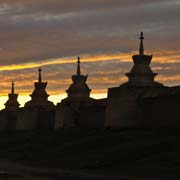
The Mongols (referred to as “Northern Yuan” by the Chinese) continued ruling Mongolia. However, there were power struggles between various Mongol groups like the Khalkha and Oirats, while the Chinese mounted multiple invasions. Eventually, in the early 16th century, the Mongol nation was reunited, and in 1557 the Altan Khan (1507 - 1582) founded the city of Hohhot, presently the capital of Inner Mongolia. He met a Tibetan spiritual leader called Sonam Gyatso in 1578, was converted to Buddhism and gave him the title “Dalai Lama”. “Dalai” means “ocean” in Mongolian, and “Lama” means “teacher” in Tibetan. This event was the spark that would reintroduce Tibetan Buddhism to Mongolia - most Mongols having been shamanists throughout their history until then. In 1585 Abtai Khan founded Erdene Zuu monastery, built on the site of the old capital of Karakorum, using building materials from the ruins. Abtai’s grandson Zanabazar became the first “Jebtsundamba Khutuktu” (“Holy Venerable Lord”), the spiritual head of Tibetan Buddhism in Mongolia, and Buddhism became the religion of all Mongols. In the early 17th century, the Mongols were ruled by Ligdan Khutugtu Khan (1588 - 1634), whose harsh rule proved unpopular. Although he signed a treaty with the Ming Dynasty to protect their northern border from the Manchus, who were in the ascendancy, several Mongolian tribes formed a coalition with the Manchus. He died on his way to Tibet, trying to evade the Manchu armies who, with their Mongol allies, were after him while he planned to attack the Yellow Hat sect of Buddhism there. His son was handed over to the Manchus, and by 1636 most Inner Mongolians had submitted to them; in 1644, the whole of China was under Manchu rule: the Qing Dynasty. By 1691 the Khalkha Mongols surrendered to the Qing Dynasty, and all of Mongolia was now under Chinese control. The Oirat or Western Mongols (also called Züüngar or Dzungar) who lived in the northern part of Xinjiang resisted the Qing conquest of Dzungaria; in 1757 - 1758 they were virtually wiped out.
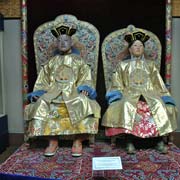
Outer Mongolia - the area of present-day Mongolia - was now under the wing of the Qing Dynasty but given relative autonomy and administered by local Khans who were descended from the bloodlines of Genghis Khan. However, the spiritual head of Tibetan Buddhism, the Jebtsundamba Khutuktu, had ultimate authority. Chinese immigration was very much restricted by the Manchus, allowing the Mongols to maintain their culture. The “Tea Road” or Siberian Road, on which great quantities of tea were transported to Europe via Siberia, passed through the only major settlement in Outer Mongolia, Urga or Khüree - now Ulaanbaatar. Manchu high officials “Ambans” were installed here, and also in Khovd and Uliastai, the administrative capital of the Manchus. During the 19th century, feudal lords and Mongolian nobility were after their own gain, taxes were collected, Chinese traders overcharged, and the people lived in poverty. Towards the end of the Qing Dynasty, the country had about 700 monasteries and around 115,000 monks. Over one-fifth of the population lived in a monastery. In 1911 the Qing Dynasty was swept aside: the monarchy was abolished, and the Republic of China was proclaimed. On 29 December 1911, Outer Mongolia declared its independence from the Qing Dynasty and the eighth Jebtsundamba Khutuktu was enthroned as the Bogd Khan (Great Khan or Emperor) of Mongolia. The Bogd Khan was born in eastern Tibet in 1869 and was, after the Dalai and Panchen Lama, the most important person in the Tibetan Buddhist hierarchy. The new Chinese republic refused to recognise Mongolia’s independence, and in 1919, Chinese troops occupied the country. Meanwhile, in 1917, the revolution that overthrew the monarchy took place in Russia. In the subsequent civil war between the “Reds” (the Bolsheviks) and the “Whites” (the Royalists), Russian troops under the command of Baron Von Ungern-Sternberg, an eccentric anti-Bolshevik Lieutenant-General of Baltic German extraction, entered Mongolia in October 1920, defeated the Chinese army in Urga (now called Niislel Khüree or Ikh Khüree) in February 1921 and unleashed a regime of horrific violence on all who opposed him. The “Mad Baron” aspired to restore the Russian monarchy and the Great Mongol Empire under the Bogd Khan. His regime lasted only five months, and he was eventually captured in south Siberia by the Bolsheviks and executed.
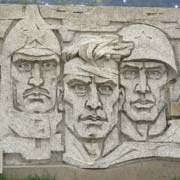
The Russian Bolsheviks now decided to support the Mongolians against the Chinese and establish a communist government. On 18 March 1921, Mongolian troops defeated the Chinese in Kyakhta (Altanbulag), and on 6 July, Russian and Mongolian soldiers marched into Khüree. The leader of the Mongolian army and a founding member of the Mongolian People’s Party was Damdin Sükhbaatar, called the “Father of Mongolia’s Revolution”. On 11 July 1921, the independence of Mongolia was proclaimed again. The Bogd Khan was the symbolic leader and Sükhbaatar Minister of the Army. The new communist government went through an unstable phase, plots were discovered, executions took place, and Sükhbaatar died on 20 February 1923, only 30 years old. A year later, on 20 May 1924, the Bogd Khan died, and on 26 November of that year, the Mongolian People’s Republic was proclaimed. It was the first communist state after the Soviet Union that heavily dominated the country. Following the rise of Joseph Stalin, the leftists gained the upper hand in Mongolia, and Khorloogiin Choibalsan (1895 - 1952) was appointed “Chairman of the Presidium of the State Little Khural”, the Head of State. A devotee to Stalin, he oversaw the violent Soviet-ordered purges of the 1930s, resulting in the deaths of 30,000 to 35,000 people. The “Great Terror” of the late thirties saw show trials of government officials, the execution of over 17,000 “counterrevolutionary” lamas, the destruction of almost 750 Buddhist monasteries while ethnic Buriads and Kazakhs, together with political dissidents, were eliminated as “enemies of the revolution”. This “Stalin of Mongolia” turned the country into a Soviet satellite state, following orders from his masters in Moscow. A personality cult developed, depicting Choibalsan as the national hero and saviour of the country.
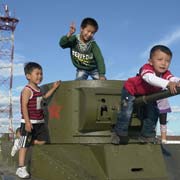
Choibalsan hoped to reunite all Mongolians into one state. In 1945, when Japan’s occupation of China ended, his troops marched south to bring about the union with Inner Mongolia. Stalin ordered him back; he had already signed deals with the allies for Soviet gains after World War II. The Sino-Soviet Treaty of that year forced China to recognise Mongolia as an independent country within its present borders - dividing Outer- and Inner Mongolia permanently. After the war, Mongolia attempted to modernise, following the Soviet model and received gradual international recognition of mainly other communist states. Following the communist victory in China, Choibalsan still hoped for a united Mongolia, but Stalin ruled it out, leading to a gradual falling out between the two. On 26 January 1952, Choibalsan died in a Moscow hospital of kidney cancer. He was succeeded on the same day by Yumjaagiin Tsedenbal, another devotee of the Soviet Union. In 1950, he had urged Choibalsan to petition Moscow to join the Soviet Union as the Republic of Tuva had done, but he had angrily rejected this. Mongolia remained a close Soviet ally, and when, after Stalin’s death, his excesses were condemned, the same happened in Mongolia in 1956 and 1962 when Choibalsan’s personality cult was condemned. Tsedenbal purged his rivals and expressed his loyalty to the Kremlin. He even submitted requests for incorporation into the Soviet Union on many occasions; these were continually rejected. At the time of the Sino-Soviet split, Tsedenbal sided with the Soviet Union, but generally, he is considered successful in maintaining relative moderate socialism.
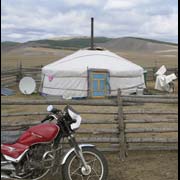
On 27 October 1961, Mongolia became a member of the United Nations; at that time, it had diplomatic relations with only 19 socialist and developing countries, but once it had UN membership, Mongolia was given de facto recognition by 100 countries, and this immeasurably strengthened its independence and sovereignty. However, Moscow still had the last say; in the 1980s, an estimated 55,000 troops were based in Mongolia, and in August 1984, Tsedenbal, while visiting Moscow, was forced into retirement, allegedly because of illness or old age and was replaced with Jambyn Batmönkh. Following the reforms in the USSR by Mikhail Gorbachev, Mongolian politics were also strongly influenced, and in late 1989 the Democratic movement gathered strength. In March 1990, the Ardchilsan Kholboo, the first democratic alliance, launched a hunger strike urging that the communist government should resign. Batmönkh decreed no force should be used, and the Politburo of the ruling Mongolian People’s Revolutionary Party resigned. A multi-party system and market economy were introduced, and in 1992, a new constitution: the “People’s Republic”, had ceased to exist. Mongolia is now a parliamentary republic with a national assembly, the State Great Khural, and a president with a largely symbolic role and a prime minister chosen by the parliament. The country has great mineral wealth, representing more than 80% of Mongolia’s exports; it now has the fastest growing economy globally. Mongolia truly has arrived on the world stage.


